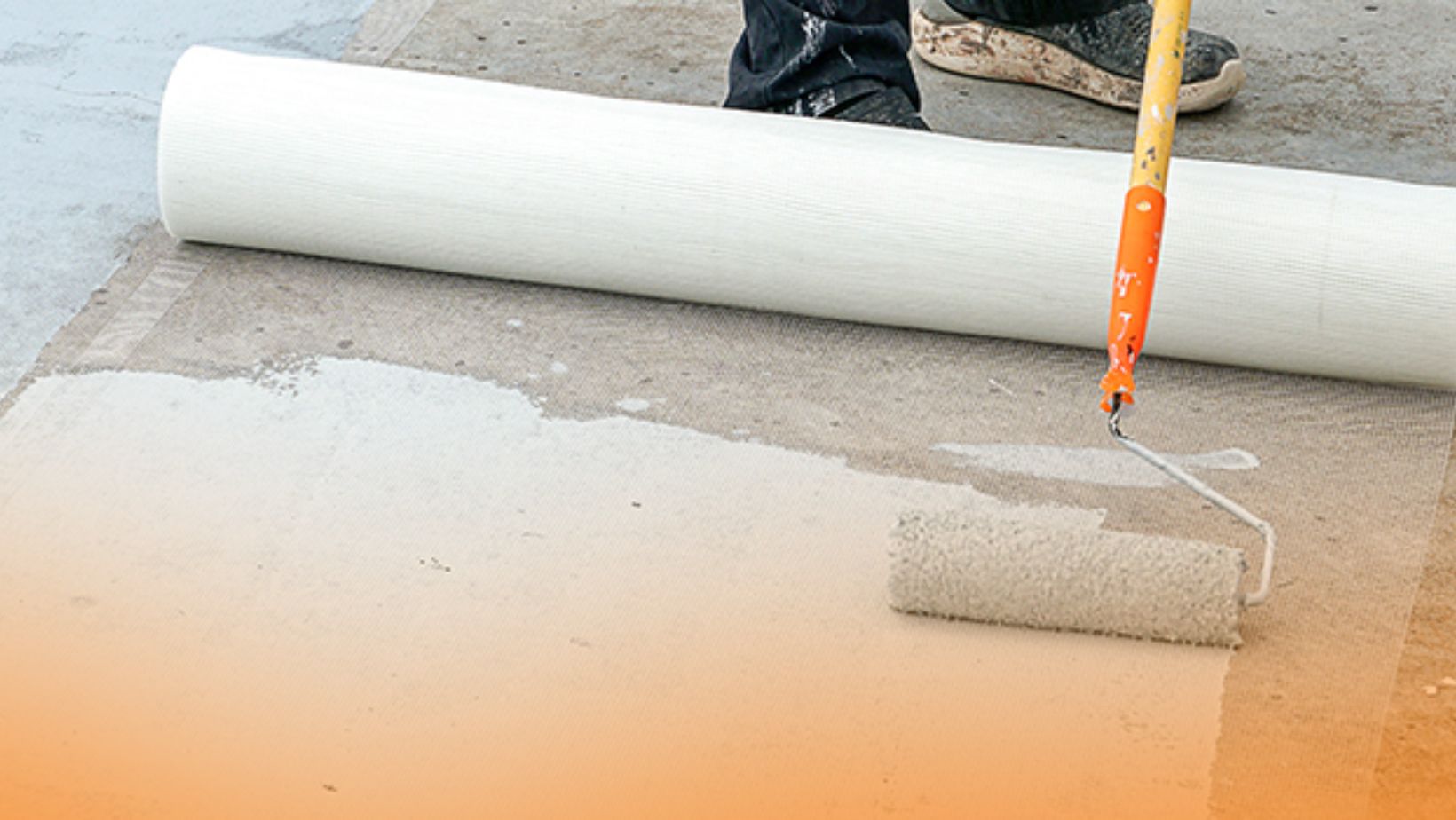Ponding water can wreak havoc on commercial roofs, causing leaks, structural damage, and shortening the lifespan of roofing systems. But what if there was a solution to not only protect your roof from ponding water but also improve its energy efficiency? Enter “commercial roof coatings as a solution for ponding water” – a game-changer in the world of commercial roofing. In this blog post, we will explore the benefits of SmartSeal’s acrylic and silicone roof coatings, dispel common misconceptions, and share some successful case studies where roof coatings have triumphed over ponding water problems.
Key Takeaways
-
- This article provides an understanding of the causes and effects of ponding water, as well as how commercial roof coatings can help protect against damage.
-
- Regular inspections and maintenance are essential for prevention, while SmartSeal’s acrylic or silicone roof coatings provide energy efficiency, durability, compatibility with existing roofs & resistance to permanent ponding water.
-
- Common misconceptions about the effectiveness of roof coatings in protecting from ponding water damage are clarified.
Understanding Ponding Water Issues
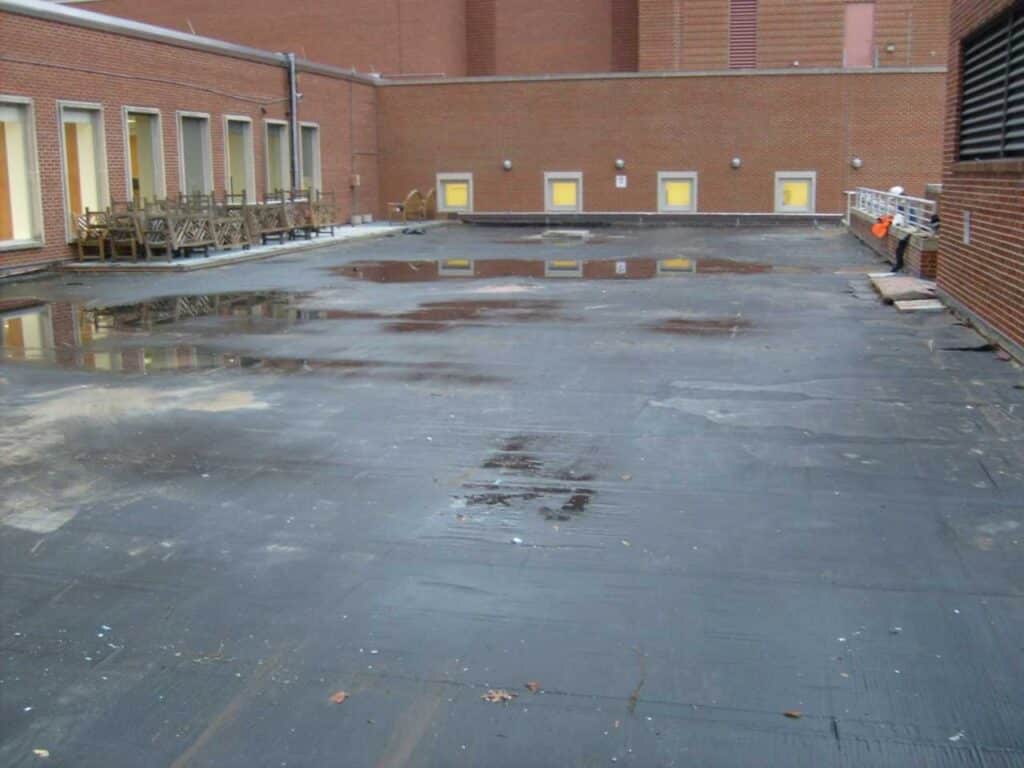
Ponding water, defined as water that remains on a flat commercial roof for more than 48 hours after precipitation has ceased, can be a major concern for building owners and facility managers. Proper maintenance and prevention of costly damage to your roofing system hinge on addressing the causes and effects of ponding water.
We will explore the realm of ponding water and the significant difference the right roof coating can make.
Causes of Ponding Water
A variety of factors can lead to ponding water on your commercial roof, including inadequate drainage, structural deficiencies, or the accumulation of debris. When water damage occurs to the substrate or insulated board stock, persistent leaks can cause these materials to eventually deteriorate or settle, resulting in the formation of stagnant pools. Addressing these causes and ensuring proper drainage for your roof is key to prevent ponding water issues.
Escalation of ponding water problems can be prevented by taking proactive measures. Regular roof inspections and maintenance can identify and address potential drainage issues or structural concerns before they become costly repairs. Don’t wait for ponding water to cause significant damage; be proactive and ensure your roof is designed and maintained to handle water accumulation effectively.
Effects on Roofing Systems
Ignoring ponding water can lead to serious consequences for your roofing system. Accumulated water can cause leaks, structural damage, and a shortened lifespan of the roof. Promptly addressing ponding water issues is fundamental to protecting your investment.
Roof coatings can play an important role in preventing and repairing damage caused by ponding water, especially when the roof drains properly. In the next sections, we will explore the differences between SmartSeal’s acrylic and silicone roof coatings and how they can help protect your roof from the detrimental effects of ponding water.
Prevention and Maintenance
The longevity of a commercial roofing system can be maintained, and ponding water issues averted, through regular inspections and maintenance. A comprehensive roof inspection should include:
-
- Observing the inspector’s work
-
- Examining the ceilings, attic, and interior walls for water staining, holes, mold, rot, and pests
-
- Inspecting roofing materials for signs of damage such as cracks, splits, curling, and missing granules
-
- Assessing the interior of the building for signs of water damage
Prevention is key; addressing ponding water issues promptly will save you time and money in the long run.
Preventing ponding water damage requires not only regular inspections but also proper drainage. Installing a drainage system, such as gutters, downspouts, and scuppers, is recommended to ensure that water is properly directed away from the roof. By taking these preventive measures, you can minimize the risk of ponding water damage and ensure the longevity of your roofing system.
Commercial Roof Coatings: Acrylic vs. Silicone

You might be curious about the best type of roof coating for protecting your commercial roof from ponding water. In this section, we will compare acrylic and silicone roof coatings, their benefits, and help you make an informed decision on the right coating for your commercial roof.
While both options have their advantages, discerning their differences and performance under various conditions is key to making an optimal choice.
Acrylic Roof Coatings
Acrylic roof coatings offer several advantages for commercial roofs. Known for their energy efficiency, durability, and compatibility with various roofing systems, acrylic coatings have become a popular choice for many building owners. They provide an extra layer of protection from the sun, helping to keep the roof cool and reducing heat transfer into the building. Additionally, they possess high reflectivity, allowing them to reflect a substantial amount of solar radiation and reduce the amount of heat absorbed by the roof.
When reinforced with materials such as polyester, acrylic coatings are designed to withstand the effects of ponding water. This added strength makes them an ideal choice for roofs that experience ponding water issues. Acrylic coatings require very little maintenance. Just washing them with soap and water can restore their original surface reflectivity if it has become dirty..
Acrylic roof coatings offer a great cost-benefit ratio compared to conventional re-roofing techniques. This makes it an attractive option for many.
Silicone Roof Coatings
Silicone roof coatings are another popular option for commercial buildings. They are known for their excellent resistance to permanent ponding water and UV rays. Silicone coatings form a seamless membrane that creates a smooth surface and, since they are not water-based, they absorb no moisture. However, despite their impressive resistance to ponding water, silicone coatings may have some limitations.
One limitation of silicone roof coatings is that they may lack abrasion and tear resistance compared to acrylic coatings. Additionally, silicone coatings may require a more difficult installation process, may have limited reflectivity, and may have shorter warranties. Nevertheless, silicone roof coatings can still provide effective protection against ponding water damage when applied correctly.
Choosing the Right Coating
In deciding between acrylic and silicone roof coatings, taking into account factors like ponding water resistance, energy efficiency, and compatibility with your existing roofing system is important. Climate is also a significant factor in determining the most suitable roof coating for your commercial building. For instance, in warm and sunny climates, acrylic roof coatings are recommended for their protection against UV rays and reflectivity, which can help reduce cooling costs.
Ultimately, the choice between acrylic and silicone roof coatings will depend on your specific needs and priorities. Both types of coatings offer unique advantages, and the best option for your commercial roof will depend on factors such as the severity of ponding water issues, the age of the roof, and your budget. By carefully considering your unique circumstances and the benefits of each coating, you can make an informed decision and protect your investment in your commercial roofing system.
Benefits of Acrylic Reinforced Roof Coatings
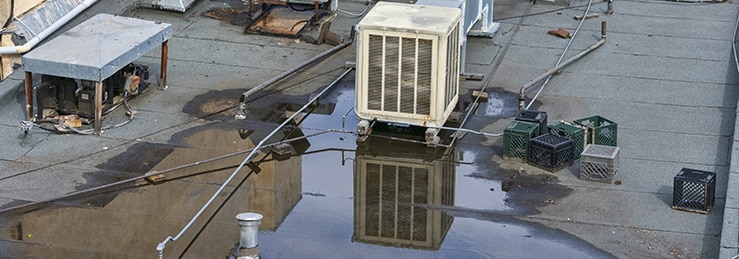
When it comes to commercial roof coatings, acrylic reinforced options offer a host of benefits, including energy efficiency, durability, and compatibility with existing roofs. Building owners can appreciate the cost savings and peace of mind that come with these high-performance coatings.
Next, we will explore the specific benefits of acrylic reinforced roof coatings and their potential to shield your commercial building from ponding water damage.
Energy Efficiency
Acrylic reinforced roof coatings can provide the following benefits:
-
- Significantly reduce energy costs by providing insulation and reflecting sunlight, resulting in lower cooling costs
-
- Offer long-term performance
-
- Decrease energy consumption
-
- Minimize maintenance costs
The reflective properties of acrylic coatings enable them to reflect solar energy from the sun, diminishing the amount of heat absorbed by the roof and enhancing energy efficiency. By using acrylic coatings on your commercial roof, you can not only protect your building from ponding water damage but also improve its energy efficiency and save on energy costs.
Durability and Longevity
Reinforced acrylic coatings offer increased durability and longevity, protecting roofs from ponding water and other damage. When combined with materials like polyester, these coatings provide a strong binding that can withstand the effects of ponding water. Additionally, their durability and longevity reduce the need for frequent roof repairs or replacements, contributing to energy savings in the long run.
By investing in a high-quality acrylic reinforced roof coating, you can ensure that your commercial roof stays protected and lasts for years to come with our proven roof coating solution.
Compatibility with Existing Roofs
One of the key advantages of acrylic reinforced roof coatings is their compatibility with a wide range of existing roofing systems. This versatility makes them an ideal solution for commercial buildings with various roofing materials, such as:
-
- Aged metal
-
- BUR (built-up roofing)
-
- Cap sheet
-
- EPDM
-
- PVC
-
- Hypalon
Acrylic roof coatings are commonly used on sloped metal roofs and provide satisfactory adhesion to most roof surfaces. By choosing an acrylic reinforced roof coating, you can ensure a seamless application and effective protection for your commercial roof, regardless of its current roofing system.
Proper Application of Commercial Roof Coatings

To ensure roof coatings work effectively in shielding your commercial roof from ponding water, their proper application is vital. Next, we will examine the critical steps in the application process, encompassing surface preparation, primer selection, and reinforcement techniques. By ensuring that your roof coating is applied correctly, you can maximize its performance and protection against ponding water damage.
Surface Preparation
Before applying a roof coating, surface preparation is a critical step that guarantees proper adhesion and performance of the coating. To prepare your roof surface for coating application, follow these steps:
-
- Assess the existing roofing system and make any necessary repairs.
-
- Clean the roof surface thoroughly, removing dirt, debris, and contaminants.
-
- Seal any cracks, voids, holes, blisters, or loose seams in the roof field or flashing.
-
- Check the weather forecast to ensure optimal conditions for coating application.
By taking the time to properly prepare your roof surface, you can ensure the best results with your roof coating application.
Primer Selection
Selecting the appropriate primer for your roofing system is vital to guarantee proper adhesion and performance of the coating. Primers are designed to prepare the roof surface for the application of the coating and enhance the adhesion of the coating to the roof substrate. When selecting a primer for your commercial roof coating, consider the following factors:
-
- Product compatibility
-
- Adhesion testing
-
- Surface type
-
- Surface preparation
-
- Safety considerations
By selecting the appropriate primer, you can ensure that your roof coating adheres effectively and provides the desired protection against ponding water and other damage.
Reinforcement Techniques
Reinforcement techniques can help improve the durability and ponding water resistance of roof coatings. Polyester fabric reinforcement, for example, provides strength and stability to the coating system, promoting greater durability. It helps to distribute stress and prevent cracking or tearing of the coating, as well as improving the tensile strength and elongation properties.
Additionally, the fabric facilitates better inter-ply bonding between layers of the coating, creating a more cohesive and robust roofing system. By incorporating reinforcement techniques into your roof coating system application, you can ensure a stronger, longer-lasting protective barrier against ponding water and other potential damage.
Case Studies: Successful Ponding Water Solutions
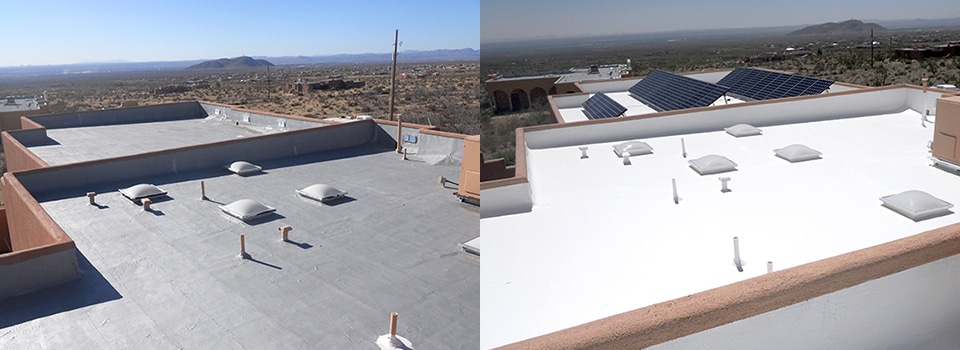
Real-life case studies can provide valuable insights into the effectiveness of roof coatings in addressing ponding water issues. In this section, we will share some successful ponding water solutions using commercial roof coatings, showcasing their potential to protect and extend the life of your commercial roof.
Flat Roof Transformation
In one successful case study, a flat roof was transformed using the following steps:
-
- Surface preparation
-
- Primer application
-
- Reinforced foundation coat
-
- Acrylic reinforced roof coating application
-
- Seam sealing
The result was a highly reflective, waterproof, and energy-efficient roofing system that effectively addressed ponding water issues and extended the life of the existing roof, ensuring the entire roof remains in good condition.
This case study demonstrates the potential of acrylic reinforced roof coatings to transform flat roofs and provide long-lasting protection against ponding water damage.
Low Slope Roof Repair
Low slope roofs can be particularly susceptible to ponding water damage. In a successful low slope roof repair case study, a silicone roof coating was used to prevent ponding water and extend the roof’s lifespan. The silicone coating provided a waterproof barrier that resisted water penetration, allowing moisture to escape while also providing strength to handle stress from standing water.
This case study highlights the effectiveness of silicone roof coatings in addressing ponding water issues on low slope roofs and extending the life of the roofing system.
Metal Roof Restoration
Metal roofs are known for their durability and longevity, but they can also be prone to ponding water issues. In a metal roof restoration case study, an acrylic coating was applied to:
-
- Prevent water damage
-
- Extend the roof’s lifespan
-
- Improve the roof’s durability
-
- Increase energy efficiency
-
- Enhance resistance to ponding water
The acrylic coating provided long-lasting protection and extended the life of the metal roof.
This case study demonstrates the potential of acrylic coatings to restore and protect metal roofs from ponding water damage and other environmental stressors.
Common Misconceptions about Roof Coatings and Ponding Water
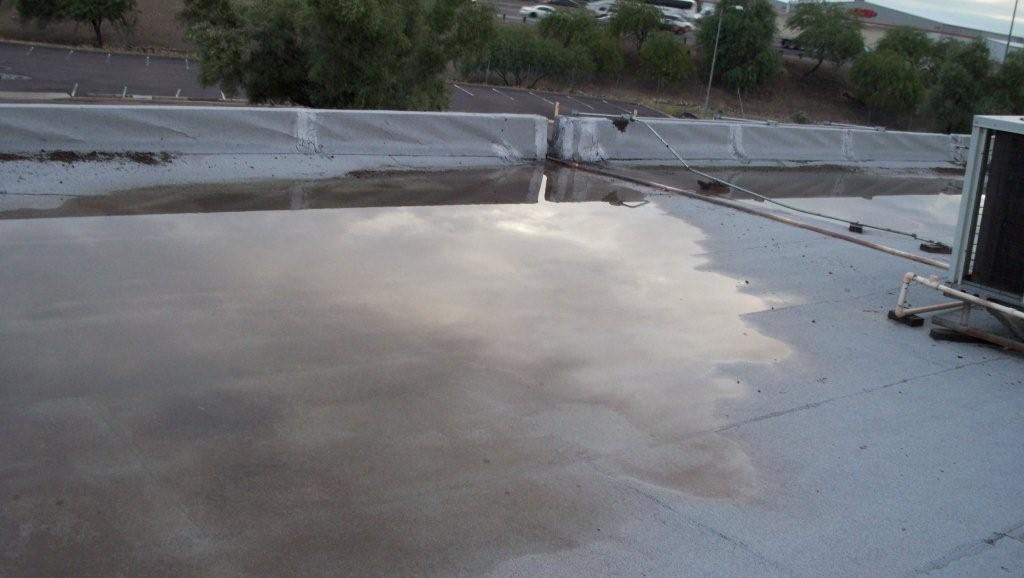
As with any industry, there are misconceptions about roof coatings and their effectiveness in dealing with ponding water. Next, we will tackle some prevalent misconceptions and shed light on the truths about the capacity of roof coatings to protect commercial roofs from ponding water damage.
Not a Substitute for Drainage
A frequent misunderstanding is the idea that roof coatings can replace proper drainage and maintenance. While roof coatings can provide additional protection against roof leaks and ponding water, they should not replace proper drainage systems.
Every roof requires positive drainage to prevent water from accumulating on the surface and causing damage. It is essential to ensure that your roof has an adequate slope and functioning drains to prevent ponding water issues and protect your investment in your roofing system.
Silicone Coating Limitations
Another common misbelief is that silicone coatings are totally impervious to water and can cope with any ponding water problem. While silicone roof coatings are highly water-resistant, the term ‘waterproof’ can be misleading, as no coating is completely impervious to water. Silicone coatings may have some limitations, such as stress cracking and primer requirements, despite their resistance to ponding water.
It is important to recognize the limitations of silicone coatings and choose a product that is best suited for your specific roofing needs.
Acrylic Coating Misunderstandings
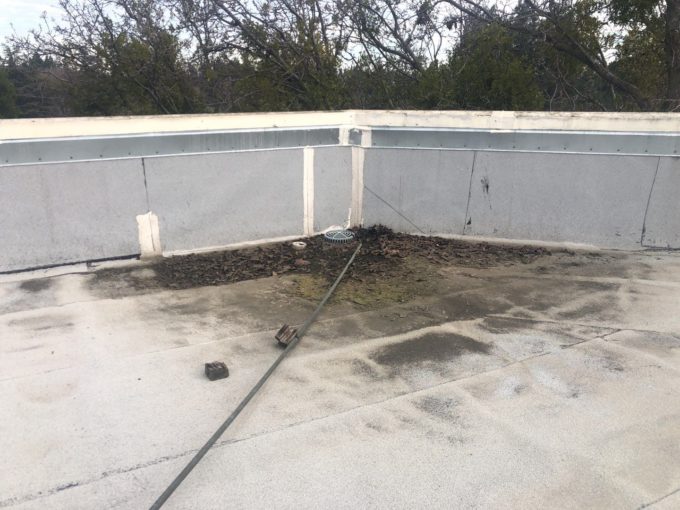
Finally, a misconception held by some is that acrylic coatings are incapable of withstanding ponding water. However, when reinforced and properly applied, acrylic coatings can effectively withstand ponding water and provide long-lasting protection. It is important to understand the capabilities of acrylic coatings and how they can be used to protect your commercial roof from ponding water damage.
By selecting a high-quality acrylic reinforced roof coating, you can ensure that your commercial roof stays protected and lasts for years to come.
Summary
In conclusion, commercial roof coatings, such as acrylic and silicone options, provide an effective solution for protecting your commercial roof from ponding water damage. By understanding the benefits, limitations, and proper application techniques of these coatings, you can make an informed decision on the best coating for your specific roofing needs. Roof coatings not only offer protection from ponding water but can also improve energy efficiency, extend the life of your roof, and save you money in the long run. So, invest in a high-quality roof coating and give your commercial roof the protection it deserves.
When it comes to commercial roof coating, SmartSeal is the top choice for St. Petersburg’s commercial roofs. Contact us today to get started.
Frequently Asked Questions
What is the best sealant for standing water?
Based on the provided text, it seems that there is no need to split it into paragraphs as it is already concise and well-structured. However, if you would like to split it into separate paragraphs, here is one possible way to do it:
For standing water, LR Waterproof Sealant is the best overall sealant, while Rubberseal Liquid Rubber Waterproofing and Protective Coating is ideal for low-pitch roofs.
For small repairs, Gorilla Waterproof Patch and Seal Tape is a great option, and Dicor Self-Leveling Lap Sealant is best for RV roofs.
How do you stop a flat roof from ponding water?
To stop a flat roof from ponding water, identify problem areas, check the drainage, add more drains, install roof crickets, re-do the coat of your roofing system, replace the membrane, fix low spots, re-pitch the rooftop, compress insulation, and install tapered polyisocyanurate.
Which is better silicone or elastomeric roof coating?
Silicone roof coatings are the clear choice in terms of longevity, thanks to their superior UV and moisture resistance.
Can water sit on a rubber roof?
It is possible for water to sit on a rubber roof as long as it has been correctly installed and regularly maintained. However, it's important to check and drain any puddles from the roof immediately in order to prevent future damage.
What are the primary differences between acrylic and silicone roof coatings?
Acrylic coatings offer durability, energy efficiency, and compatibility with roofing systems, while silicone coatings offer excellent resistance to ponding water and UV rays but may require primers and may be prone to stress cracking.


